| Volume 2012, Issue 16 | May 9, 2012 |
|

Pick and Gather at Riverdance Farms and Merced River Fair:
June 2-3
National Conference on Engineering & Ecohydrology for Fish Passage:
June 5-7
|
|

|
Key Highlights
April 16, 2012 - April 29, 2012
Calaveras River Juvenile Migration Monitoring continued at Shelton Road (RM 28) during the reporting period. A total of 170 O. mykiss were captured, increasing the season total to 607. A total of 345 Chinook salmon were also captured, bringing the season total to 621.
Stanislaus River Juvenile Migration Monitoring continued at Oakdale (RM 40) during the reporting period. A total of 1,167 Chinook salmon were captured, increasing the season total to 23,596. Five O. mykiss were captured, increasing the season total to 26. Information is not available from monitoring at Caswell State Park (RM 8).
Tuolumne River Juvenile Migration Monitoring continued at Waterford (RM 30) during the reporting period. A total of 211 Chinook salmon were captured, increasing the season total to 3,406. Monitoring at Grayson (RM 5) continued during the reporting period. A total of 10 Chinook salmon were captured, increasing the season total to 45. No O. mykiss have been captured this season at Waterford or Grayson.
Mokelumne River Juvenile Migration Monitoring continued at Vino Farms (RM 54) during the reporting period. A total of eight Chinook salmon were captured, increasing the season total to 12,356. Three O. mykiss were captured, increasing the season total to 37. Monitoring at the Bypass trap (RM 38) continued during the reporting period. A total of 99 Chinook salmon were captured, increasing the season total to 101. Eight O. mykiss were captured, increasing the season total to 13. Monitoring at Golf (RM 38) continued during the reporting period. A total of 68 Chinook salmon were captured during the reporting period, increasing the season total to 947. Three O. mykiss were captured, increasing the season total to 147.
San Joaquin River Juvenile Migration Monitoring at Mossdale continued during the reporting period. A total of 851 Chinook salmon were captured, increasing the season total to 1,357. A total of six O. mykiss were captured, increasing the season total to nine.
Tuolumne River Weir Monitoring (RM 22) continued during the reporting period. A total of 12 Chinook salmon passed upstream through the weir, increasing the season total to 2,891. Three O. mykiss passed upstream through the weir during the reporting period, increasing the season total to 14.
San Joaquin River Conditions. San Joaquin River flow at Vernalis ranged from 2,293 cfs to 3,373 cfs. Daily average water temperature in the San Joaquin River ranged from 59.5°F to 65.8°F at Vernalis, and from 61.6°F to 68.5°F at Mossdale. Daily average dissolved oxygen (DO) in the San Joaquin River ranged from 9.0 mg/L to 10.7 mg/L at Mossdale, and from 6.8 mg/L to 9.8 mg/L in the deep-water ship channel (measured at Rough 'n Ready Island).
Delta Exports. Combined total exports (state and federal pumps) fluctuated during the reporting period, ranging from 1,234 cfs to 3,798cfs.
|
|
2011/12 Calaveras River Juvenile Migration Monitoring
The Calaveras River rotary screw trap at Shelton Road (RM 28) sampled continuously between April 16 and April 29. A total of 170 O. mykiss were captured, increasing the 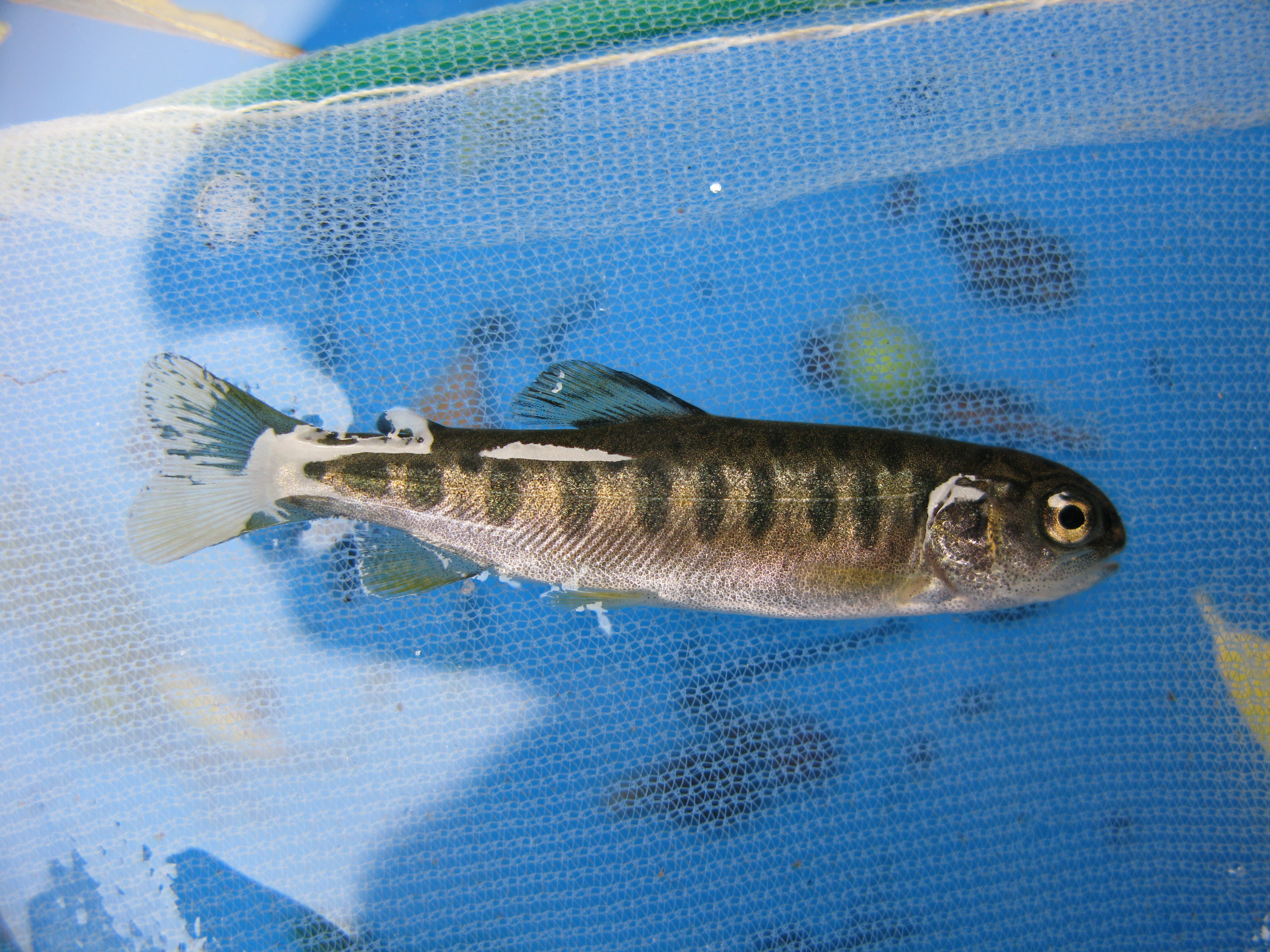 season total to 607. Daily catch ranged from 4 to 28 individuals (Figure 1). Average forklengths and weights for 168 O. mykiss are provided in Table 1. A majority of the O. mykiss measured were YOY (<100 mm), and were rated as fry (n=57), parr (n=101) and silvery parr (n=7), but an Age 1+ (100-299 mm) and an Adult (>300 mm) were also observed. season total to 607. Daily catch ranged from 4 to 28 individuals (Figure 1). Average forklengths and weights for 168 O. mykiss are provided in Table 1. A majority of the O. mykiss measured were YOY (<100 mm), and were rated as fry (n=57), parr (n=101) and silvery parr (n=7), but an Age 1+ (100-299 mm) and an Adult (>300 mm) were also observed.
A total of 345 Chinook salmon were captured during the reporting period, increasing the season total to 621. Daily catch ranged between 1 and 51 Chinook (Figure 2). Most of the Chinook salmon measured were smolts (n=310) but parr (n=32) were also observed. Average forklengths and weights are provided in Table 1.
Daily average combined flows from New Hogan Dam (NHG) and Cosgrove Creek (COS) fluctuated between 65 cfs and 160 cfs, and at Bellota (MRS) flows ranged from 8 cfs to 43 cfs (Figure 3). Instantaneous water temperatures recorded at the trap ranged from 52.7ºF to 58.8ºF, and turbidity ranged from 0.30 NTU to 4.02 NTU.
Table 1. Biosampling data for salmonids captured at Shelton Road (RM 28) between April 16 and April 29, 2012. Parenthesis indicates range.
 Five trap efficiency experiments were conducted with naturally spawned juvenile Chinook salmon. Preliminary estimates of capture efficiency are provided in Table 2. Table 2. Trap efficiency tests conducted at Shelton Road (RM 28) between April 16 and April 29, 2012. 
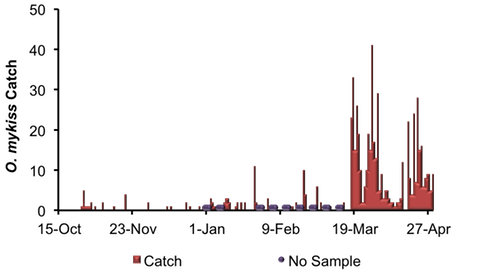
Figure 1. Daily O. mykiss catch at Shelton Road between October 15, 2011, and April 29, 2012.
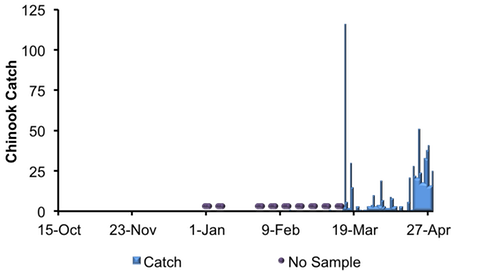
Figure 2. Daily Chinook salmon catch at Shelton Road between October 15, 2011, and April 29, 2012.
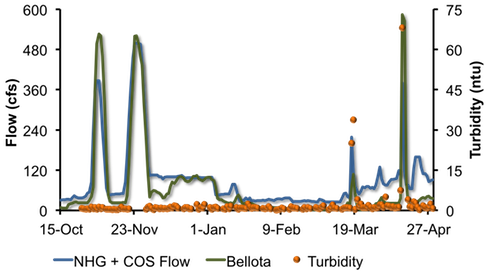
Figure 3. Daily Calaveras River flows recorded at New Hogan Dam and Cosgrove Creek combined (NHG + COS) and at Bellota (MRS) and turbidity recorded at the trap between October 15, 2011, and April 29, 2012.
|
2011/12 Stanislaus River Juvenile Migration Monitoring
 The Stanislaus River rotary screw trap at Oakdale (RM 40) sampled continuously between April 16 and April 29. A total of 1,167 Chinook salmon were captured, increasing the season total to 23,596. Daily catch ranged between 19 and 148 Chinook (Figure 4). Most of the Chinook salmon measured were smolt (n=973), but fry (n=6) and parr (n=183) were also observed. Average forklengths and weights of all measured Chinook salmon are provided in Table 3. The Stanislaus River rotary screw trap at Oakdale (RM 40) sampled continuously between April 16 and April 29. A total of 1,167 Chinook salmon were captured, increasing the season total to 23,596. Daily catch ranged between 19 and 148 Chinook (Figure 4). Most of the Chinook salmon measured were smolt (n=973), but fry (n=6) and parr (n=183) were also observed. Average forklengths and weights of all measured Chinook salmon are provided in Table 3.
Five O. mykiss fry were captured during the reporting period, increasing the season total to 26.
Table 3. Biosampling data for salmonids captured and measured at Oakdale (RM 40) between April 16 and April 29, 2012.
 No trap efficiency experiments were conducted during the reporting period. Daily average flows at Goodwin Dam (GDW) ranged from 1,500 cfs to 2,017 cfs, and at Ripon (RIP) ranged from 1,402 cfs to 1,900 cfs. Instantaneous water temperatures taken at the trap ranged from 50.3ºF to 54.3ºF, and turbidity ranged from 0.65 NTU to 2.92 NTU. 
Figure 4. Daily Chinook salmon catch at Oakdale (RM 40) and daily average Stanislaus River flows at Goodwin Dam (GDW) and Ripon (RIP) between January 1, 2012, and April 29, 2012.
Information from monitoring at Caswell State Park (RM 8) is not available between April 16 and April 29.
|
2012 Tuolumne River Juvenile Migration Monitoring
The Tuolumne River rotary screw trap at Waterford (RM 30) operated continuously between April 16 thru April 29. A total of 211 juvenile Chinook salmon were captured, increasing the season total to 3,406. Daily catch ranged between 1 and 44 Chinook (Figure 5). Most of the Chinook salmon measured were smolts (n=202), but parr (n=9) were also observed. Average forklengths and weights of all measured Chinook salmon are provided in Table 4.
No O. mykiss have been captured so far this season.
Table 4. Biosampling data for Chinook salmon captured and measured at Waterford (RM 30) between April 16 and April 29, 2012. Parentheses indicate range.
One trap efficiency experiment was conducted with naturally spawned juvenile Chinook salmon marked caudal fin orange (CFO). Preliminary estimate of capture efficiency is provided in Table 5.
Table 5. Trap efficiency tests conducted at Waterford (RM 30) between April 16 and April 29, 2012. Daily average flows at La Grange (LGN) ranged from 169 cfs to 372 cfs. Instantaneous water temperatures taken at the trap ranged from 58.6ºF to 69.0ºF, and turbidity ranged from 0.77 NTU to 3.27 NTU.
Figure 5. Daily Chinook salmon catch at Waterford (RM 30) and daily average Tuolumne River flows at La Grange (LGN) and between December 1, 2011, and April 29, 2012. 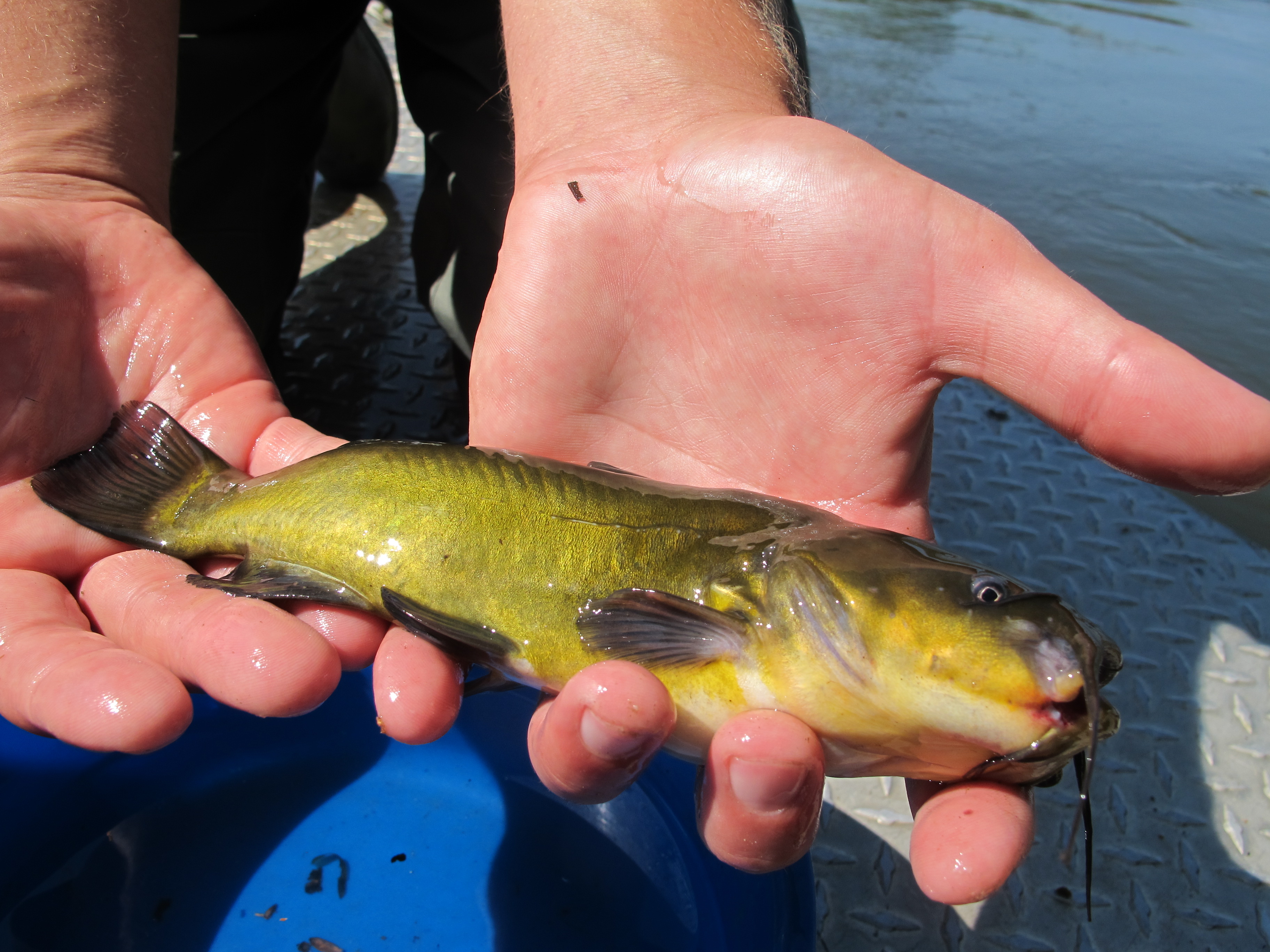 | |
Black bullhead captured at Grayson.
|
The Tuolumne River rotary screw traps at Grayson (RM 5) operated continuously between April 16 and April 29. A total of 10 Chinook salmon were captured during the reporting period, increasing the season total to 45. Daily catch ranged between 0 and 4 Chinook (Figure 6). Average forklengths and weights of all measured Chinook salmon are provided in Table 6. All Chinook salmon captured were smolts (n=10). No O. mykiss have been captured so far this season. Table 6. Biosampling data for Chinook salmon captured and measured at Grayson (RM 5) between April 16 and April 29, 2012. Parentheses indicate range.
No trap efficiency experiments were conducted. Daily average flow at Modesto (MOD) ranged from 296 cfs to 490 cfs. Instantaneous water temperatures taken at the trap ranged from 59.7ºF to 72.5ºF, and turbidity ranged from 1.45 NTU to 9.43 NTU.Figure 6. Daily Chinook salmon catch at Grayson and Tuolumne River flow recorded at Modesto (MOD) between January 1 and April 29, 2012.
|
2011/12 Mokelumne River Juvenile Migration Monitoring
The Mokelumne River rotary screw trap at Vino Farms (RM 54) sampled intermittently between April 16 and April 29. A total of eight juvenile Chinook salmon were captured, bringing the season total to 12,356. Daily catch ranged between zero and two Chinook (Figure 7).
Three O. mykiss were captured, increasing the season total to 37.
Daily average flows from Camanche Reservoir (CMN) were stable, ranging from 243 cfs to 295 cfs. Instantaneous water temperatures ranged between 54.7°F and 56.8°F, and instantaneous turbidity ranged between 2.49 NTU and 5.43 NTU.
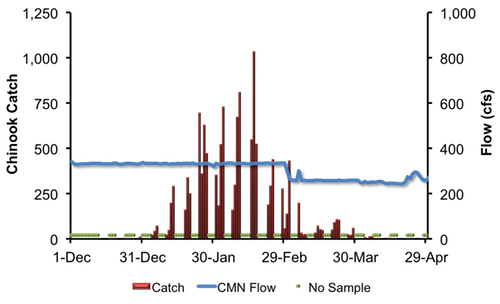 Figure 7. Daily juvenile Chinook catch at Vino Farms (RM 54) and daily average Mokelumne River flows at Camanche Reservoir (CMN) between December 1, 2011, and April 29, 2012. The Mokelumne River Bypass trap (RM 38) sampled intermittently between April 16 and April 29. A total of 99 juvenile Chinook salmon were captured during the reporting period, increasing the season total to 101. A total of eight O. mykiss were captured during the reporting period, increasing the season total to 13. Daily average flows recorded at Woodbridge (WBR) ranged from 129 cfs to 192 cfs (Figure 8). Instantaneous water temperatures ranged between 59.7°F and 68.5°F, and turbidity ranged between 2.19 NTU and 5.19 NTU.
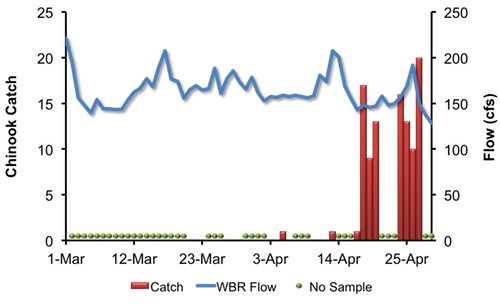
Figure 8. Daily juvenile Chinook catch at the Bypass trap (RM 38) and daily averageMokelumne River flows at Woodbridge (WBR), between March 1, 2012, and April 29, 2012. The Mokelumne River rotary screw trap at Golf (RM 38) sampled intermittently between April 16 and April 29. A total of 68 juvenile Chinook salmon were captured, increasing the season total of 947 (Figure 9). Three O. mykiss were captured during the reporting period, increasing the season total to 147. (Note: 135 were identified as hatchery origin).
Figure 9. Daily juvenile Chinook catch at the rotary screw trap at Golf (RM 38) and daily average Mokelumne River flows at Woodbridge (WBR), between December 15, 2011, and April 29, 2012.
|
2012 San Joaquin River Juvenile Migration Monitoring
The Kodiak trawling that is conducted by the California Department of Fish and Game on the San Joaquin River near Mossdale (i.e. the Mossdale Trawl) continued during the reporting period. Ten days (ten tows per day) of trawling were conducted between April 16 and April 29. A total of 851 juvenile Chinook salmon were captured, increasing the season total to 1,357. Catch ranged between 9 and 166 Chinook per 10 tows (Figure 10).Six O. mykiss were captured during the reporting period, increasing the season total to nine.

Figure 10. Chinook salmon catch (per 10 tows) at the Mossdale Trawl and San Joaquin River flow recorded by Vernalis (VNS), 2012.
|
2011 Tuolumne River Weir Adult Migration Monitoring
The Tuolumne River Weir and Vaki Riverwatcher (RM 22) sampled continuously between April 16 and April 29. A total of 12 Chinook salmon were detected as they passed upstream of the weir, increasing the season total to 2,891. Daily passage ranged between zero and two Chinook salmon.
Three O. mykiss were detected passing upstream of the weir during the reporting period, increasing the season total to 14. One of the fish was positively identified as hatchery origin (ad-clipped) and the other two were positively identified as natural, increasing the season total to four and ten, respectively.
Other fish passing upstream of the weir included 8 American shad and 707 Sacramento suckers (Table 7).
Daily average flows in the Tuolumne River ranged from 169 cfs to 372 cfs at La Grange (LGN; RM 50) and from 296 cfs to 490 cfs at Modesto (MOD; RM 17). Note: flows downstream of La Grange may be higher than dam releases due to accretion and Dry Creek inflows (Figure 11). Instantaneous water temperatures measured at the weir ranged from 61.7˚F and 75.0˚F and daily average water temperatures at Modesto ranged from 60.4˚F and 74.8˚F (Figure 12). Instantaneous turbidity at the weir ranged between 0.68 NTU and 6.18 NTU (Figure 13), and dissolved oxygen ranged between 8.75 mg/L and 12.32 mg/L (Figure 14).
Table 7. Net passage counts for all species between April 16 and April 29, 2012 at the Tuolumne River (RM 22).
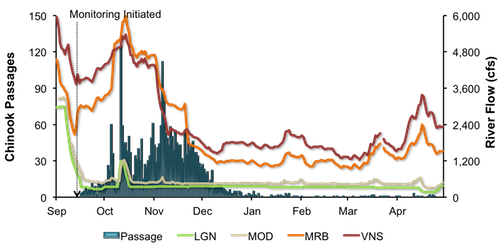
Figure 11. Daily upstream Chinook passage at the Tuolumne River weir in relation to daily average flows (cfs) recorded in the Tuolumne River at La Grange (LGN) and Modesto (MOD), and in the San Joaquin River at Maze Road Bridge (MRB) and Vernalis (VNS), September 1, 2011 and April 29, 2012.
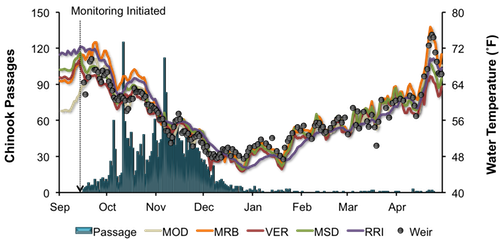
Figure 12. Daily upstream Chinook passage at the Tuolumne River weir in relation to instantaneous water temperature recorded at the weir, and daily average water temperature recorded in the Tuolumne River at Modesto (MOD) and in the San Joaquin River at Maze Road Bridge (MRB), Vernalis (VER), Mossdale (MSD) and Rough & Ready (RRI), September 1, 2011 and April 29, 2012.

Figure 13. Daily upstream Chinook passage at the Tuolumne River weir in relation to instantaneous turbidity recorded at the weir, September 1, 2011 and April 29, 2012.

Figure 14. Daily upstream Chinook passage at the Tuolumne River weir in relation to instantaneous dissolved oxygen recorded at the weir, and daily average dissolved oxygen recorded in the San Joaquin River at Mossdale (MSD) and Rough & Ready (RRI), September 1, 2011 and April 29, 2012.
|
San Joaquin River Conditions
During the reporting period, flow in the San Joaquin River at Vernalis ranged from 2,293 cfs to 3,373 cfs (Figure 15). Daily average water temperature in the San Joaquin River ranged from 59.5°F to 65.8°F at Vernalis, from 61.6°F to 68.5°F at Mossdale, and from 60.7°F to 69.7°F at Rough 'n Ready Island (Figure 16). Daily average dissolved oxygen (DO) in the San Joaquin River fluctuated from 9.0 mg/L to 10.7 mg/L at Mossdale, and from 6.8 mg/L to 9.8 mg/L in the deep-water ship channel (measured at Rough 'n Ready Island; Figure 17).
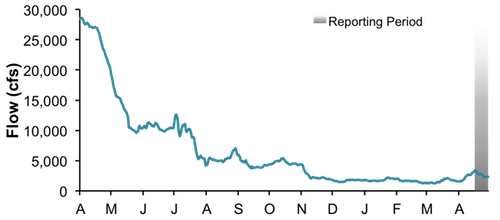
Figure 15. San Joaquin River flow at Vernalis from April 1, 2011, through April 29, 2012.
Figure 16. San Joaquin River daily average water temperature at Vernalis, Mossdale, and Rough 'n Ready from April 1, 2011, through April 29, 2012.
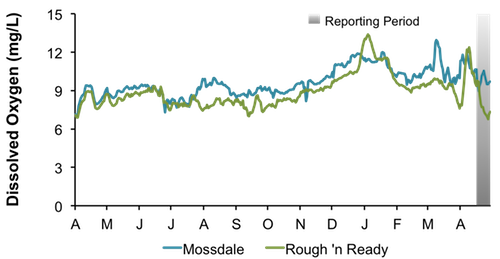
Figure 17. San Joaquin River daily average dissolved oxygen at Mossdale and Rough 'n Ready, from April 1, 2011, through April 29, 2012.
|
Delta ExportsMean daily pumping at the C.W. Jones Pumping Plant (federal pumps previously known as Tracy Pumping Plant) ranged from 812 cfs to 1,631 cfs (Figure 18). Mean daily pumping at the Harvey O. Banks Pumping Plant (state pumps) ranged from 413 cfs to 2,350 cfs. Combined total exports (state and federal pumps) fluctuated during this reporting period, ranging from 1,234 cfs to 3,798 cfs.
Figure 18. Daily exports at the state and federal pumping stations from April 1, 2011, through April 29, 2012.
|
|
|
|
|
|
|